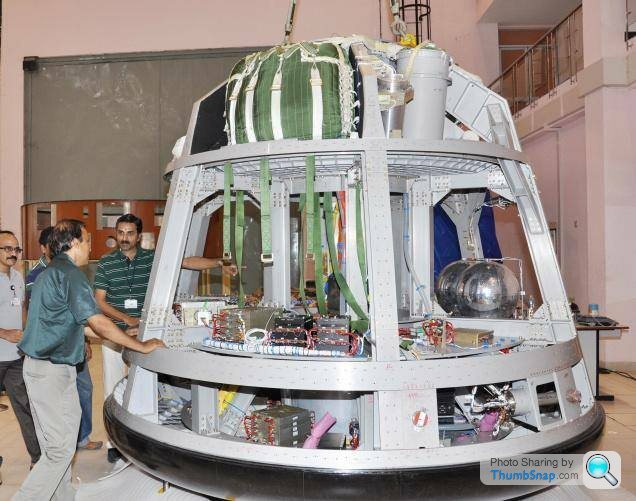India to test Manned spacecraft
Discussion

India will launch an unmanned crew module in
December onboard a heavy rocket to test its re-
entry into the atmosphere for the country's
maiden human space flight.
"We will send an unmanned crew module on the
experimental GSLV-Mark III rocket in December
and test its re-entry into the earth's
atmosphere for a human space flight plan in
future," Indian Space Research Organisation
(Isro) Chairman K. Radhakrishnan told
reporters in Bangalore on the margins of an
engineers conclave.
Weighing 3.6 tonnes, the crew module will be
put into orbit 100-120km up in a satellite and
brought back to Earth for checking its re-entry
characteristics when carrying two Indian
astronauts in the proposed human space flight.
"Though the actual human space flight will be
in an orbit around earth at a height of 270km
for a week, the experimental flight with the crew
module in a spacecraft will go up to
100-120km above earth to test its heat shield
survive very high temperatures (about 1,500
degrees Celsius) during the re-entry into the
atmosphere."
The crew module will have a parachute that will
open up after re-entry into the atmosphere and
fall into sea for retrieval.
"The parachute will open up for soft landing of
the spacecraft carrying the crew module in the
Bay of Bengal, about 450 km away from
Andamans (islands), and will be retrieved by a
boat."
The previous UPA government had sanctioned
Rs. 145 crores to Isro for developing a crew
module that will fly two Indian astronauts into
space, space suits, life support systems and
related technologies for the human space flight
programme.
The heavy rocket (GSLV) will, however, have a
passive cryogenic stage - liquid nitrogen at
super cooled temperature and gaseous nitrogen
instead of liquid hydrogen and liquid oxygen.
The space agency is integrating the rocket with
the crew module at its Sriharikota spaceport in
Andhra Pradesh, about 90 km northeast of
Chennai.
I know it's a bit old and it's the Daily Wail...but....
http://www.dailymail.co.uk/news/article-2068930/Ho...
http://www.dailymail.co.uk/news/article-2068930/Ho...
Latest info

"There is frenetic activity at Sriharikota for the maiden lift-off of India’s newest and the biggest launch vehicle in December, which will put an unmanned crew module into orbit.
The mission is a stepping stone to the Indian Space Research Organisation (ISRO) ultimately sending astronauts into space in the module.
The 3.65-tonne module will get de-mated from the topmost cryogenic stage at an altitude of 125 km and return to the earth. At an altitude of 15 km, there will be an “aerial ballet,” featuring three huge parachutes which will open up one after the other to slow down the module’s descent. The module is expected to splash down in the sea near the Andaman archipelago and will be recovered by the Indian Coast Guard and ISRO personnel. The entire flight from the lift-off to the splash-down will last about 20 minutes. It is a passive, experimental and sub-orbital mission.
ISRO Chairman K. Radhakrishnan said, “Everything is progressing well” for the GSLV-MkIII launch in December. The rocket weighs 630 tonnes and is 42.4 metres tall.
“We are ready. Everything is pucca. ” Thiruvananthapuram, which has built both the GSLV-MKIII and the unmanned crew module. Two gigantic strap-on motors, each of which will use 200 tonnes of solid propellants, have been strapped around the core stage in the second launch pad. The core stage will use 110 tonnes of liquid propellants. Above the core stage is the cryogenic stage. The module will be “encapsulated” with the cryogenic stage on November 26.
S. Somanath, Project Director, GSLV-MKIII, called it India’s “biggest, heaviest and the next generation” launch vehicle." - Alexandra Albani

"There is frenetic activity at Sriharikota for the maiden lift-off of India’s newest and the biggest launch vehicle in December, which will put an unmanned crew module into orbit.
The mission is a stepping stone to the Indian Space Research Organisation (ISRO) ultimately sending astronauts into space in the module.
The 3.65-tonne module will get de-mated from the topmost cryogenic stage at an altitude of 125 km and return to the earth. At an altitude of 15 km, there will be an “aerial ballet,” featuring three huge parachutes which will open up one after the other to slow down the module’s descent. The module is expected to splash down in the sea near the Andaman archipelago and will be recovered by the Indian Coast Guard and ISRO personnel. The entire flight from the lift-off to the splash-down will last about 20 minutes. It is a passive, experimental and sub-orbital mission.
ISRO Chairman K. Radhakrishnan said, “Everything is progressing well” for the GSLV-MkIII launch in December. The rocket weighs 630 tonnes and is 42.4 metres tall.
“We are ready. Everything is pucca. ” Thiruvananthapuram, which has built both the GSLV-MKIII and the unmanned crew module. Two gigantic strap-on motors, each of which will use 200 tonnes of solid propellants, have been strapped around the core stage in the second launch pad. The core stage will use 110 tonnes of liquid propellants. Above the core stage is the cryogenic stage. The module will be “encapsulated” with the cryogenic stage on November 26.
S. Somanath, Project Director, GSLV-MKIII, called it India’s “biggest, heaviest and the next generation” launch vehicle." - Alexandra Albani
MartG said:
Kinda looks that way Eric - I can't see where a crew would fit in there
You've clearly never seen Indian transport, the 200 astronauts cling to the sides
But joking aside, it's fantastic to see another space race and it can only mean greater advances. I was reading about Ghandian Engineering recently and it is incredible what India is capable of when it comes to low cost development.
Gassing Station | Science! | Top of Page | What's New | My Stuff




